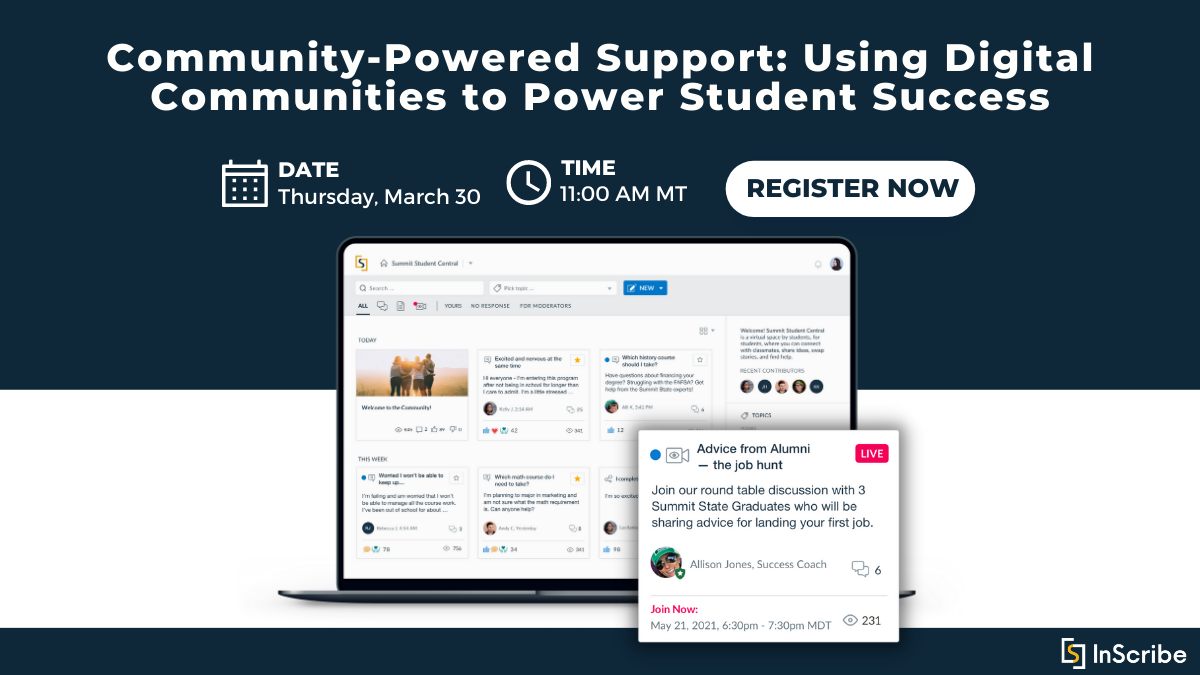In recent months, there has been a surge of conversation about the role of Artificial Intelligence (AI) in higher education. While much attention has been given to AI’s impact on teaching methods and the impact of student use of AI on assessment, equal attention must be given to understanding AI's influence on human interactions and connections. A case in point is the rise of AI tutors to help answer questions and guide students through their curriculum.
Read MoreToday’s students are often managing many other responsibilities alongside their academic commitments. Work, family obligations, and personal interests create a complicated balancing act. To accommodate, many choose the flexibility of online and hybrid learning. This approach is crucial to keeping non-traditional students active in higher education, however, it also comes with key challenges.
Read MoreBelonging and staying connected to peers play a crucial role for online and asynchronous students navigating the complexities of pursuing an online education. Unlike brick-and-mortar learning environments, online settings often lack the opportunities to build the supportive network that is naturally created on campus, in the classroom or in additional in-person spaces. Campus learning provides a sense of community and validation, reducing feelings of isolation and increasing the likelihood of academic success.
Read MoreGreater Commonwealth Virtual School (GCVS) is a public virtual school in Massachusetts that offers a synchronous K-12 educational program with a strong emphasis on providing a safe and inclusive learning environment for students across the state. Recognizing the need to foster student connections beyond traditional in-person settings, Dr. Sarah Jordan, Director of Accountability, and student outreach coordinator, Chris Dillon, observed students utilizing collaboration docs to connect and communicate during live classes. While acknowledging the value of shared docs for collaboration, GCVS also understood the importance of monitoring these interactions to ensure a supportive and respectful space. To address this, GCVS introduced InScribe, a school-sanctioned virtual community platform that allows students to connect with peers for advice, emotional support, and most importantly: a genuine sense of belonging.
Read MoreIndiana University offers over 220 online programs, serving a diverse student body of more than 8,000 online students from 164 countries. With a deep history in online education since its first distance course in 1995, the university has experienced impressive growth in its online programs. In response to the escalating demand for fully online education, Whitnie Powell, Director of Enrollment Management and Student Services, Stephanie Tinkel, Associate Director of Enrollment Management, and Kayla Scroggins, Associate Director of Online Student Services at Indiana University Online (IU Online) embarked on a thorough analysis and transformation of its student support model, prioritizing a student-centered approach that nurtures a sense of belonging, peer connection, and an overall enriched educational experience.
Read MoreCreating a learning environment that fosters a sense of belonging for students is a top priority among higher education institutions. While on-campus learners may have innate opportunities to become involved with campus community and a clearer path to a sense of belonging, online learners may experience additional barriers that prevent them from making meaningful connections.
Read MoreToday, almost 6 million students in the United States are completing their degree, entirely online. Many of these learners are also juggling other commitments, such as family and work, pushing study times to evenings and weekends.
Read MoreDigital support communities allow Western Governors University students to connect with peers and faculty to ask questions, find solutions and solve problems while working at their own pace.
Read MoreStudents that have easy access to support, where and when they need it the most are more likely to stay on track, understand expectations, and overcome challenges outside the classroom. Digital communities paired with traditional su
Read MoreBy Daryl Love, AVP of Career Services and Professional Development at Kentucky State University
A large part of the educational experience we provide at Kentucky State University (KSU) centers around relationships. Many students come to KSU because they feel a sense of community and belonging. Our goal in partnering with InScribe to create a digital community space was to elevate and accelerate these connections, especially in the absence of face-to-face interaction during the COVID-19 pandemic.
Read MoreBy Dr. Beverly Schneller, Vice President for Academic Quality, Research and Innovation, Kentucky State University
At Kentucky State University, we know how critical it is for students to have easy access to key support services across our campus. When COVID-19 made it difficult for students to connect with these teams in person, we created a digital alternative - a virtual student services community built on InScribe.
Read MoreBy Dr. Omid Fotuhi, Director of Learning Innovation at WGU Labs
People have a fundamental need to belong. A sense of belonging, the feeling that one has a secure and valued place within a group, is a core condition that is required for an individual to feel safe, confident, and able to contribute.
Read MoreOne question we often get from our institutional partners is, “How do I know if my community is healthy?” Truthfully, there isn’t a single answer. The shape and flow of a community changes depending on its purpose and the individuals it serves. There is, however, one consistent piece of advice we give every partner - recognize that your community is made up of a diverse set of members who have different needs, goals, and behaviors. Community engagement isn’t “one size fits all” and healthy communities thrive when their members can engage in the ways that work best for them.
Read MoreIn recent years, post-secondary education has experienced an increase in activities taking place in digital spaces. Digital learning offers a more flexible model, which is critical for today’s students who are often working or parenting while they learn. Whether engaging with content and curriculum, communicating with peers and faculty, or connecting with institutional services, technology makes education accessible and relevant for these students.
Read MoreMore students are learning online, and whether that shift is temporary given the pandemic, or it represents a growing trend for how students will choose to learn in the future, ensuring a quality online experience is top of mind among educators. An important part of that online experience is preserving student-to-student and student-to-faculty connections, collaboration, and communication.
Read MoreDigital communities are an excellent way to help students connect - to information, classmates, support resources, even potential employers.
But it’s not enough to simply offer a community and expect that students will show up. Students need to understand and see the value of the community so they are motivated to join and participate.
Read MoreIn higher education, research increasingly demonstrates how influential a student’s sense of belonging is to key outcomes including persistence and emotional well-being. Today, creating a strong community with students is more important than ever as we return for a fall semester full of change and uncertainty.
Read MoreAs faculty return to teaching this fall, they do so in a world full of change and uncertainty. Many classes are moving online, new technologies must be adopted, and limitations on how instructors can interact with students and colleagues are driving up levels of stress and anxiety. Today, more than ever, institutions need strategies to help faculty stay connected, supported, and heard.
Read MoreTo say that college students today have a lot on their plate is a major understatement. One in five students is a parent1 and 44 percent of student parents are working full-time while enrolled in college.2 For these learners life is a constant balancing act between family, work, and academic commitments.
Read MoreWhen colleges and universities think about the value of digital communities, they are usually thinking about their students. That makes sense because students encounter many new experiences, challenges, and uncertainties as they navigate their journey to graduation. Digital communities are a great way to help students find information, connect with people and resources, and build a sense of confidence that will help them succeed.
Read More




















